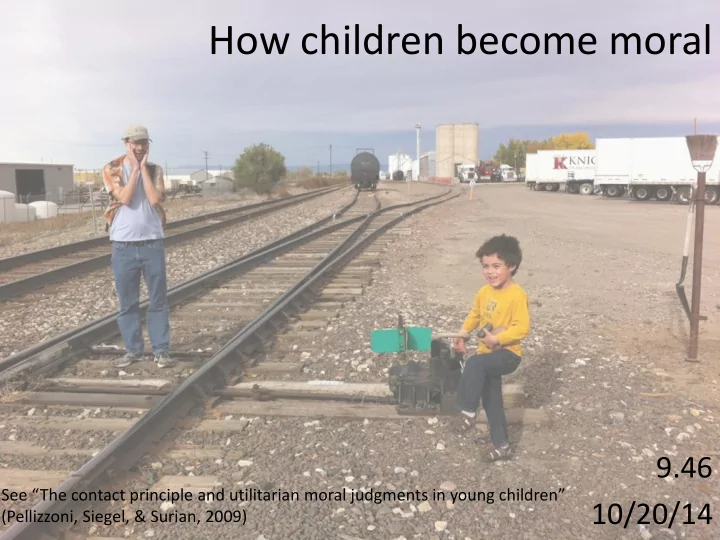

How children become moral 9.46 See “The contact principle and utilitarian moral judgments in young children” 10/20/14 (Pellizzoni, Siegel, & Surian, 2009)
1. What three features does Hamlin claim cooperative systems require? • Which does Warneken & Tomasello (2013) address? • Which do Hamlin’s "morality plays" address?
1. What three features does Hamlin claim cooperative systems require? • Which does Warneken & Tomasello (2013) address? • Which do Hamlin’s "morality plays" address? Moral goodness Moral behavior Moral understanding & evaluation Moral judgment Retribution
Plan for today 1. Early moral judgment 2. Early moral behavior 3. A little bit about learning
Distinguishing helping and hindering Hit Caress Help Hinder Premack & Premack (1997)
Distinguishing helping and hindering Hit Caress Help Hinder Premack & Premack (1997)
Distinguishing helping and hindering Hit Caress Help Hinder Premack & Premack (1997)
Distinguishing helping and hindering Dishabituation (to horizontal hit) Habituation Premack & Premack (1997)
Preferring helping to hindering Square hinders Triangle helps Child chooses Hamlin & Wynn (2011)
Preferring helping to hindering % infants choosing character who… 2. How does Hamlin check whether infants are responding to "low level cues"? Hamlin, Wynn, & Bloom(2007)
Hamlin, Wynn, & Bloom (2007) Preferring helping to hindering % infants choosing character who…
Preference for retribution 5-month-olds 8-month-olds 19-month-olds Hamlin et al. (2011)
Preference for retribution 5-month-olds 8-month-olds 19-month-olds Hamlin et al. (2011)
Preference for retribution 5-month-olds 8-month-olds 19-month-olds Hamlin et al. (2011)
Mental state matters Preference-knowledge Preference-ignorance Nopreference-knowledge Hamlin et al. (2013)
Mental state matters Preference-knowledge Preference-ignorance Nopreference-knowledge Hamlin et al. (2013)
Mental state matters Preference-knowledge Preference-ignorance Nopreference-knowledge Hamlin et al. (2013)
Mental state matters Preference-knowledge Preference-ignorance Nopreference-knowledge Hamlin et al. (2013)
Mental state matters Preference-knowledge Preference-ignorance Nopreference-knowledge Hamlin et al. (2013)
Mental state matters 3. Imagine infants are doing something simpler, e.g.: a) They like elephants who want to help the lion, and figure everyone knows what the lion wants. b) They like elephants who help the lion get what the lion has chosen before c) They like elephants who help the lion get what the elephant knows the lion has chosen before. c) They like elephants who open doors for the lion. That is so nice! Re-draw the choice plot. Hamlin et al. (2013)
Mental state matters • As soon as infants can DO the mental state work it seems to be tied in to morality. • What would happen with induced false beliefs, which infants seem to have some implicit access to without being able (much later) to answer explicit questions? Baillargeon et al., 2010
Expectations of fairness 16-month-olds look longer at (and choose!) the fair distributor Is this really a “moral” consideration? Geraci & Surian (2011)
Expectations of fairness Is this really a “moral” consideration? Yes — effect vanishes when the recipients are inanimate Geraci & Surian (2011)
Moral behavior “Parental presence and encouragement do not influence helping in young children” (Warneken & Tomasello, 2013) 3. Which finding relies on accepting a null hypothesis? Which findings don’t?
Moral behavior 4. What if infants help more in the presence of a parent, but also take into account that their parent isn’t helping? Devise an experiment that would distinguish between this hypothesis and the one advanced by the authors (i.e., that infants help spontaneously and the parent’s presence doesn’t matter).
Moral behavior: instrumental helping • 18 month olds, novel situations • Control: same situation but adult has a neutral facial expression and never indicates there’s a problem • 22 of 24 infants helped at least once • Almost always before adult makes eye contract or speaks Warneken & Tomasello, 2006
Material rewards reduce helping • Neutral: no response at all to the child. • Praise: “Thank you, [CHILD’S NAME]; that’s really nice!” • Reward: “For this, you get a cube.” Warneken & Tomasello, 2008
Toddlers reward and punish 19-23 month olds Hamlin et al., 2011
Connecting judgment and performance • Sheskin et al., 2014: “Life -history theory explains childhood moral development” – Infants don’t need to behave morally in order to get resources; older children do. – Natural selection has timed moral development based on typical social environments in childhood. • Warneken & Tomasello , 2009: “This developmental timeline makes sense as infants initially act mainly within the protected environment of their family and do not have to self-regulate via social norms because they are supervised by adults. However, during middle childhood, when they start to act more autonomously with a larger number of people, they need to be concerned with whether the target of their altruistic act reciprocates or judges their reputation according to internalized social norms.”
Learning does occur… somehow. 5. "The claim that specific socialization practices are not the only source of prosocial behaviors is not in conflict with the fact that growing up in a "normal" social environment contributes positively to children’s behavioral development more generally, as prosocial behaviors are one of the various behaviors that may be affected if children's social interactions are disrupted." (Warneken & Tomasello, 2013)
So what are parents doing? • Common caveat: “The present studies therefore rule out formal moral instruction and experience in complex social institutions as sources of the cooperative principles, but they cannot tease apart the effects of children’s own observational learning, directions from parents and other adults, feedback from other children, and intrinsically guided developmental processes.” (Olson & Spelke, 2007) • Even very careful observational studies can’t get beyond correlation. • “Inductive parenting” promotes prosocial behavior (Hoffman, 2000): adult highlights causal structure (e.g., excluding another child makes him feel hurt or sad) but doesn’t need to help with motivation.
6. Come up with a thesis statement connecting these findings about early moral cognition to either (a) the contribution of reasons vs. emotion to moral judgment or (b)the question of whether moral cognition is uniquely moral.
Recommend
More recommend